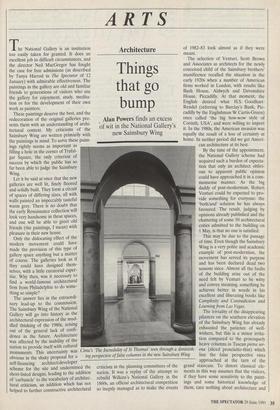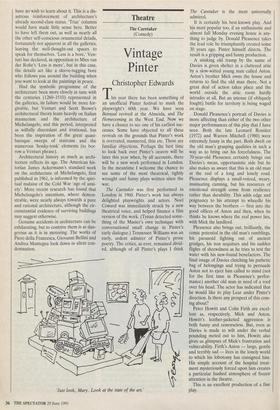ARTS
Architecture
Things that go bump
Alan Powers finds an excess of wit in the National Gallery's new Sainsbury Wing The National Gallery is an institution too easily taken for granted. It does an excellent job in difficult circumstances, and the director Neil MacGregor has fought the case for free admissions (as described by Tanya Harrod in The Spectator of 12 January) with admirable effectiveness. The paintings in the gallery are old and familiar friends to generations of visitors who use the gallery for enjoyment, study, medita- tion or for the development of their own work as painters.
These paintings deserve the best, and the redecoration of the original galleries pre- sents them with an understanding of archi- tectural context. My criticisms of the Sainsbury Wing are written primarily with the paintings in mind. To serve these paint- ings rightly seems as important as filling a hole in the corner of Trafal- gar Square, the only criterion of success by which the public has so far been able to judge the Sainsbury Wing. Let it be said at once that the new galleries are well lit, finely floored and solidly built. They form a circuit of spaces of differing sizes, all with walls painted an impeccably tasteful warm grey. There is no doubt that the early Renaissance collection will look very handsome in these spaces, and one will be able to greet old friends (the paintings, I mean) with pleasure in their new house. Only the dislocating effect of the modern movement could have made the provision of this type of gallery space anything but a matter of course. The galleries look as if they could have designed them- selves, with a little curatorial exper- tise. Why then, was it necessary to find a world-famous architectural firm from Philadelphia to do some- thing so simple? The answer lies in the extraordi- nary lead-up to the commission. The Sainsbury Wing of the National Gallery will go into history as the architectural expression of the mud- dled thinking of the 1980s, arising out of the general lack of confi- dence in the future. Architecture was affected by the inability of the nation to provide itself with cultural monuments. This uncertainty was obvious in the shaky proposal for a self-financing architect/developer scheme for the site and undermined the short-listed designs, leading to the addition of 'carbuncle' to the vocabulary of architec- tural criticism, an addition which has not helped to further constructive architectural Cima's The Incredulity of St Thomas' seen through a diminish- ing perspective of false columns in the new Sainsbury Wing criticism in the planning committees of the nation. It was a replay of the attempt to rebuild Wilkins's National Gallery in the 1860s, an official architectural competition so ineptly managed as to make the events of 1982-83 look almost as if they were meant.
The selection of Venturi, Scott Brown and Associates as architects for the newly conceived child of the Sainsbury brothers' munificence recalled the situation in the early 1920s when a number of American firms worked in London, with results like Bush House, Aldwych and Devonshire House, Piccadilly. At that moment, the English desired what H.S. Goodhart- Rendel (referring to Barclay's Bank, Pic- cadilly by the Englishman W. Curtis-Green) once called 'the big bow-wow style of Corinth, USA', and were willing to import it. In the 1980s, the American invasion was equally the result of a loss of certainty at home. In neither period did we get Ameri- can architecture at its best.
By the time of the appointment, the National Gallery scheme had acquired such a burden of expecta- tion that only an architect oblivi- ous to apparent public opinion could have approached it in a corn- monsense manner. As the big daddy of post-modernism, Robert Venturi could be expected to pro- vide something for everyone: the 'both/and' solution he has always favoured. The result, judging by opinions already published and the chattering of some 50 architectural critics admitted to the building on 1 May, is that no one is satisfied.
This may be due to the passage of time. Even though the Sainsbury Wing is a very polite and academic example of post-modernism, the movement has served its purpose and has been declared dead two seasons since. Almost all the faults of the building arise out of the need felt by Venturi to be witty and convey meaning, something he achieves better in words in his excellent and liberating books like Complexity and Contradiction and Learning from Las Vegas.
The triviality of the disappearing pilasters on the southern elevation of the Sainsbury Wing has already exhausted the patience of well- wishers, but this is a minor irrita- tion compared to the grotesquely heavy columns in Tuscan pietra ser- ena (sliced prosciutto-thin) which line the false perspective vista approached at the turn of the grand staircase. To distort classical ele- ments in this way assumes that the visitors, if they have some sensitivity to the paint- ings and some historical knowledge of them, care nothing about architecture and
have no wish to learn about it. This is a dis- astrous reinforcement of architecture's already second-class status. 'True' columns would have made little sense here. Better to have left them out, as well as nearly all the other self-conscious ornamental details, fortunately not apparent in all the galleries, leaving the well-thought-out spaces to speak for themselves. 'Less is a bore,' Ven- turi has declared, in opposition to Mies van der Rohe's 'Less is more', but in this case, the details act like a sleeve-tugging bore who follows you around the building when you want to look at the paintings in peace.
Had the symbolic programme of the architecture been more closely in tune with the centuries (1260-1510) represented in the galleries, its failure would be more for- givable, but Venturi and Scott Brown's architectural theory leans heavily on Italian mannerism and the architecture of Michelangelo, and this period, interpreted as wilfully discordant and irrational, has been the inspiration of the great quasi- baroque sweeps of staircase and the numerous 'honky-tonk' elements (to bor- row a Venturi phrase).
Architectural history as much as archi- tecture reflects its age. The American his- torian James Ackermann's standard work on the architecture of Michelangelo, first published in 1961, is informed by the spiri- tual malaise of the Cold War 'age of anxi- ety'. More recent research has found that Michelangelo's intentions, where demon- strable, were nearly always towards a pure and rational architecture, although the cir- cumstantial evidence of surviving buildings may suggest otherwise.
Genuine accidents in architecture can be exhilarating, but to contrive them is as dan- gerous as it is in motoring. The works of Piero della Francesca, Giovanni Bellini and Andrea Mantegna look down in silent con- demnation.
'Just look, Mary. Look at the state of the art.'



















































 Previous page
Previous page